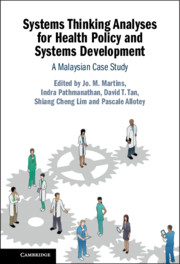Tables
3.2Changes in poverty, urbanisation, safe deliveries and infant mortality, Malaysia, 1960–1980
3.3Epidemiological transition and causes of death, peninsular Malaysia, 1982–1990
3.4Changes in poverty, urbanisation, safe deliveries and infant mortality, Malaysia, 1980–2000
3.5Infant mortality, poverty and rural living, Malaysia, 2000
3.6Changes in poverty, urbanisation, safe deliveries and infant mortality, Malaysia, 2000–2016
3.7Life expectancy by sex and years of age, Malaysia, 1999 and 2017
3.HAge distribution of the population of Malaysia, 1957–2017
3.LNumber of people per nursing personnel, Malaysia, 1964–2016
4.4Percentage of institutional deliveries and immunisation coverage, 1970–1990
4.5Gaps and challenges and action taken in integrating preventive and curative services
4.6Quality monitoring and improvement: examples of experiences in primary care
4.7Top three reasons for encounters in public and private clinics
4.9Doctors reporting involvement in health promotion during routine patient encounters
4.11Clinical outcomes for the management of diabetes and hypertension
5.1Regional disparity in secondary care in different regions of Malaysia, 1972
5.2Increased availability of specialist care in MoH hospitals, 1970–1997
5.3Laboratory services increased in sophistication in tandem with the availability of specialist clinicians
5.5Distribution of high-cost imaging technology in MoH and private hospitals, 1997
5.6Referral experiences reported by doctors in public sector health centres
5.8Expenditure on and utilisation of public and private hospitals, 2012 and 2017
5.11Sources of funds in the private sector, Malaysia, 2012 and 2017
5-aInteraction of forces that shaped the evolution of STC during the 1960s and 1970s
5-bSTC services: interaction of forces that shaped the evolution during the 1980s and 1990s
6.1Examples illustrating key features in the spectrum of Malaysian vertical disease control approaches that subsequently merged with mainstream health services
6.2Percentage coverage of immunisation in Malaysia, 1970–2017
6.4Prevalence of selected NCD risk factors in Malaysia for adults aged ≥18 years, 1996–2015
6.5Incidence rate of emerging and re-emerging communicable diseases (per 100,000 population)
6.6Illustrative examples of the rapid emergence of and varied challenges posed by emerging diseases in Malaysia
6.aTen principal causes of admissions and deaths, 1960, 1974 and 1996
7-AComparison of scope of services before and after privatization
8.1Summary of interacting influences on the evolution of the health workforce, 1960s and 1970s
8.2Production of allied health personnel (selected categories), 1956–1995
8.3Evolution of the composition of the health workforce (selected categories) 1955–2015
8.4Selected health staff, utilisation rates and health outcomes
8.5Summary of interacting influences on the evolution of the health workforce, 1980s and 1990s
8.7Number of people per doctor and per nursing staff, 1970–2000
8.8Access to health facility (with doctor, medical assistant or community nurse)
8.9Summary of interacting influences and the evolution of the health workforce, 2000s and 2010s
8.10Examples of specialisation and the relevant governance mechanisms
8-ARapid increase in medical schools and new medical graduates
9.1Total and per capita expenditures on health, Malaysia, 1997–2016
9.2Public and private health expenditures, Malaysia, 1997–2017
9.3Licensed private health care facilities, Malaysia, 2007–2017
11.2Export and import value of pharmaceutical products to Malaysia by product category, 2013–2017
12.1Differing imperatives influenced the system behaviour in formulating health legislation
12.2Illustrative features of leadership during Malaysia’s experience in introducing HPV immunisation
14.1Key linkages between building blocks in the case studies
14.2Examples of health-related components of sub-systems in the cultural adaptation template



